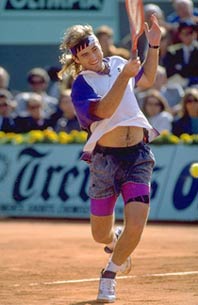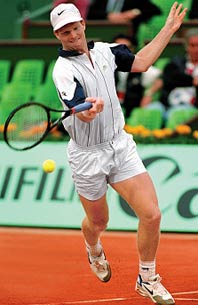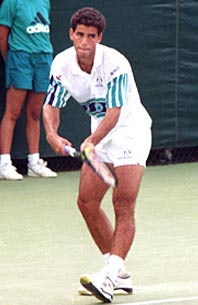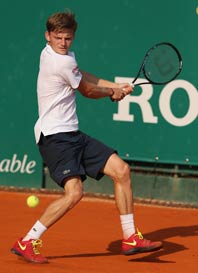|
TennisOne Lessons Where Have All the Youngsters Gone? Adam Gale Tennis is full of good and familiar stories: the king facing down the pretender, the ageing champion reliving his glory days, the talented underachiever finally realizing her potential. One of the most compelling tales is the changing of the guard, the arrival of a new generation of fresh-faced, ambitious youngsters to challenge the established pros. It’s a story that, in the men’s game, hasn’t been told for some time.
Tennis: an Old Man's Game? It has been well documented over recent years that professional tennis is aging. There are, remarkably, no teenagers in the ATP Top 100. The median age of that same elite group has risen from 25 to 27 in only the last decade (August 2002-August 2012), and more players than ever are having success well into their thirties.  The received wisdom is that this phenomenon is the result of the greater physicality of the modern sport. To compete nowadays, they say, a player has to be stronger and faster and tougher than before, and teenagers just can’t compete on that level yet. It’s an apparently sensible argument, but I believe it only tells part of the story. After all, as the table above shows, it isn’t just teenagers who are now struggling. There are currently only nine players under the age of 23 in the Top 100. Are we supposed to believe this is because 22-year-olds cannot compete physically? Usain Bolt ran the fastest 100m in the history of the world when he was 22 years old. Yohan Blake, the second fastest man of all time, won the World Championships when he was 21. Ashton Eaton took the world record for the Decathlon at 24. Clearly, it is ludicrous to argue that there is some physical barrier stopping a conditioned athlete in their early twenties from breaking through. It should also be noted that even teenagers are not necessarily held back by the muscular nature of the modern game. A scrawny, 18-year-old Agassi might have struggled to make his mark on the gladiatorial tour of 2013, but an 18-year-old Rafa had a good 15-20lbs of muscle on Andre. I think he could have handled it. Nadal may have been an exceptional case, but the fact remains that the failure of the generation born in the 1990s to make their presence felt cannot be blamed entirely on the current physicality of the sport. If a 21 or 22-year-old Murray or Djokovic were playing today, they would still be contending for the majors.
So if it’s not just physicality holding back the next generation of tennis stars, then what else is? Could it be that they’re just not that good? Or are they missing something that previous generations had? Consider the breakout players of the late 80s and early 90s for a moment. Sampras, Ivanisevic and Krajicek joined Becker in amping up the power of the serve. Agassi and Seles started hitting groundstrokes with a hitherto unseen level of aggression. Graf and Courier broke new ground with the runaround forehand. These youngsters had something new, something that the older, established players did not possess. The same cannot be said of the younger generation today. Eighteen-year-olds are now hitting the ball the same way as 30-year-olds. They no longer have a significant competitive advantage by virtue of having a more ‘advanced’ technique. If the playing field has been leveled, it makes sense that it would take longer for players to jump from the standard of the juniors to the standard of the seniors, particularly on a consistent basis. Add to that the fact that most 20 or 21-year-olds haven’t quite reached their physical peak, it becomes understandable that the best of the 90s births are not yet regularly making major quarter-finals or better. Their time will come, however, and probably soon. Let’s take a look at the most promising of this new generation, and assess their individual chances are of making it in the big league.
Milos Raonic Born: 12/27/90 Milos Raonic grew up idolizing Pete Sampras, and it shows. They both have remarkable, fluid, dominating serves. But there the comparison stops. Raonic is more likely to be another Isner than another Sampras. The Canadian moves like a man of 6’5, and ultimately, without movement, big weapons can only get a tennis player so far. Against opponents who can neutralize those weapons, he will always struggle, as was clear in his last two grand slam defeats to Murray and Federer respectively. Will Raonic ever become greyhound-quick, or develop superb defensive skills? No. There is room for improvement in these weaker areas, however, and as a proven winner of titles, he should definitely crack the Top 10. Expect him to go far, then, but only as far as his legs will carry him.
Grigor Dimitrov Born: 5/16/91 Baby Fed. Dimitrov dislikes being called that, apparently, but the similarities are stark. The Bulgarian’s smooth, elegant style clearly recalls the Swiss. Much like the early Roger Federer and Richard Gasquet, Dimitrov has been accused of having too many shots to know what to do with, of failing to convert ability into wins. Whether he will follow Federer’s footsteps or Gasquet’s remains to be seen, but he is widely seen as having the potential to be a major winner. Dimitrov has already put together some fine tennis this year, going toe-to-toe with the likes of Murray and Nadal on their favorite surfaces. Their endurance and physical strength arguably gave them the edge in these encounters. It could be that some serious gym time is all Dimitrov needs to raise his game to the next level, and then who knows how far he could go?
Bernard Tomic Born: 10/21/92 Fans of a certain vintage British children’s television show shared a few chuckles when Bernie received the nickname ‘Tomic the Tank Engine’. The young Australian has developed an unfortunate reputation for inexplicably lackluster performances on court, and outright hostility off it. His game is highly effective, however, and his lazy style deceptive. Like Dimitrov, Tomic has all the raw ingredients for greatness, and should only improve as he gets physically stronger. His mental game is a serious cause for concern at the moment, but if —and it’s a big if —the Australian can consistently replicate the level he showed in bringing down Djokovic in the Hopman Cup in January, great things will surely follow. The Rest Though the three players profiled above are the favorites to get the ‘Most Likely to be World Number One Award’, there are others in their age group who also have potential. Goffin and Nishikori, for instance, are fine all-round players, but there’s a chance they may prove to be lightweights stuck in a heavyweight division. Jerzy Janowicz deserves a mention too. It’s been hard to ignore the 6’8 Pole since he hammered four Top 20 players on the way to the final of the Paris Masters in November last year. His serve was predictably impressive then, but it was his movement and audacious drop shots that stood out. If that Janowicz turns up —and so far this year he has distinctly failed to do so —he too will be a future Top 10 player.
The Future This up-and-coming generation has its share of unrealized talent, but the fact remains that we are unlikely to find the next Federer or Nadal in their number. Such players are rare indeed. It’s possible that Dimitrov and Tomic could one day be multiple major winners, if they find that magical, winning quality that separates the good from the great. Even if that does happen, however, they will still have to deal with arguably the strongest Big Four in history, and probably the strongest Top 10. These guys will have their day, then, but it’s unlikely to happen for another three or four years.
Your comments are welcome. Let us know what you think about Adam Gale's article by emailing us here at TennisOne. |





